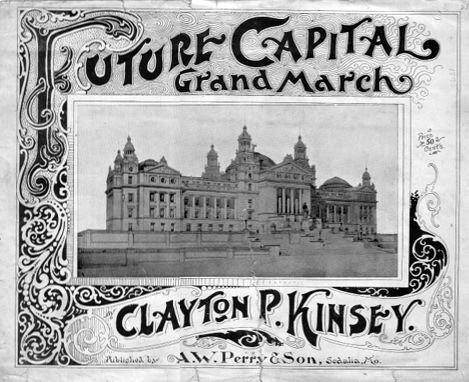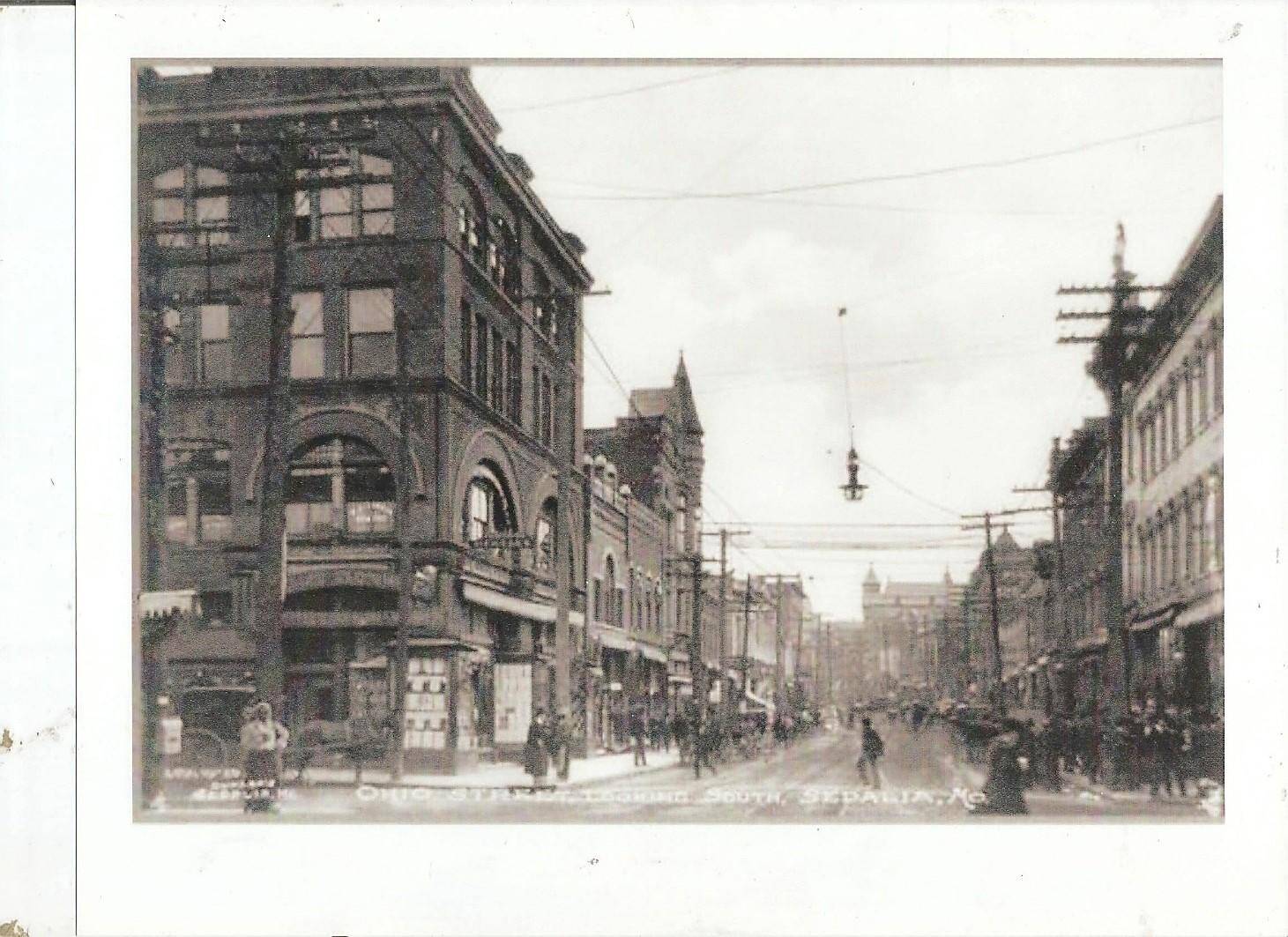“In the future, everyone will be world-famous for fifteen minutes.” This line, credited to Andy Warhol from a Stockholm exhibit catalog in 1968, has gone through several attributions and convolutions over the years, including being ascribed to Marshall McLuhan. Where ever it originated, it has become a kind of hereditary promise for generations of Americans and most of us have indeed had our 15 minutes of celebrity, plus or minus.
My own fifteen minutes came in 1974, when an exuberant young man came up to me at the end of the first Scott Joplin Ragtime Festival in Sedalia and asked for my autograph. For the next 43 years my wife humorously teased me remarking, “Yes, Lawrence had his fifteen minutes, though it was more like fifteen seconds, and he has managed to stretch it out in his mind all these years!” (It used to embarrass me, but I’d sure like to hear her say it again just one more time…)
Well, if people get their few moments of celebrity, then I suppose places do as well. That is certainly the case with Sedalia, Missouri. However, before I launch into my “Sedalia, a place where America’s music began,” soliloquy, let me remind you that Sedalia’s story up to the Ragtime Era is quite phenomenal. You see Sedalia had only been incorporated as a place during the Civil War. In less than 35 years it had grown from a muddy bunch of shacks at the temporary MoPac railhead into a substantial city, thanks to the crossing of two major rail lines by 1895.
In fact, in 1896, Sedalia had serious designs on becoming the state capital after a long and hard campaign by state representative and attorney John Bothwell, et al., to have the capital moved from Jefferson City. The issue failed, carrying some western towns and Kansas City but losing overwhelmingly in the eastern communities, especially in St. Louis. Now since the subject is fifteen minutes of fame, I point out that those of you who have visited Sedalia have possibly stayed at the Bothwell Hotel, been treated for various ailments at the Bothwell Hospital and Medical Center or have been entertained at he Bothwell Lodge State Park. And to give the whole affair its full fifteen minutes, the A.W. Perry & Son Music Company issued the “Future Capital Grand March” sheet music, though it turned into a grand surrender.
 Sedalia didn’t let the capital removal failure stop them from seeking out other jewels under state government proprietorship. The land set aside for the state capital had already been used to lure the University of Missouri from Columbia after the administration building fire there, but that too had failed. Finally, the land was to be used to acquire the site of the annual Missouri State Fair. Instead of scholars and politicians, the Queen City of the Prairie finally only managed to attract livestock (Comparative comments are simply too easy here, so I’ll move on.)
Sedalia didn’t let the capital removal failure stop them from seeking out other jewels under state government proprietorship. The land set aside for the state capital had already been used to lure the University of Missouri from Columbia after the administration building fire there, but that too had failed. Finally, the land was to be used to acquire the site of the annual Missouri State Fair. Instead of scholars and politicians, the Queen City of the Prairie finally only managed to attract livestock (Comparative comments are simply too easy here, so I’ll move on.)
The 1890’s, of course, was the Ragtime era in Sedalia. It was the signing of the “Maple Leaf Rag” contract on August 10, 1899 between the publisher John Stark and the composer Scott Joplin that made Sedalia internationally famous, and for considerably more than the allocated fifteen minutes.
When I was putting together the “Sedalia in the Ragtime Era” exhibit for the KATY Depot museum (only recently removed), I was amazed by how much information I was able to gather on Sedalia in the 1890’s. An old friend and downtown Sedalia historian, Rebecca Imhauser, led me to resources that provide a multi-dimensional image of the city in Scott Joplin’s time.

Becky Imhauser’s own illustrated books on Downtown Sedalia, All Along Ohio Street (2006) and All Around Downtown (2011) are treasures of historical information and images of literally every downtown address.
Next, she gave the Sedalia Ragtime Archive the 1898 publication, The American Journal of Progress. This article provided a photographic overview of what was described as “the marvelous growth of a large and prosperous community which has grown from a wilderness to a great and busy metropolis within this closing quarter of the century.”
Mrs. Imhauser also provided a pristine copy of the Sedalia Board of Trade’s brochure prepared for the Capital Removal campaign. It is also profusely illustrated with salient details about the city. I already had acquired the 1108-page tome, The History of Pettis County, Missouri by I. MacDonald Demuth (1882) that traced the rapid growth of the area in just 20 years. DeMuth also published an 1895 volume titled A Feast of Cold Facts. It provided a sort of condensed and updated version of his definitive work. Finally, Michael Cassidy wrote Defending a Way of Life in 1989. It described the nineteenth-century industrialization of American through the lens of Sedalia’s experience and provided a retrospective image of Sedalia in the Ragtime Years.
Rarely has the fame of a person or place been so well documented as was Sedalia in the 1890s. It is also very important to emphasize that Sedalia had an important cadre of promoters advocating for its fame. It was probably Brun Campbell who began the crusade for Sedalia’s notoriety that culminated in his 1940’s letter writing effort to newspaper publishers. That resulted in a widely circulated article variously titled, “Did you know ragtime music began in Sedalia?” Another early devotee of Sedalia’s ragtime story was “Ragtime Bob Darch” who relentlessly hounded Sedalia to promote itself as the ragtime capital and proceeded to tell Sedalia’s story around the continent. Thus, when Rudi Blesh and Harriett Janis named Sedalia the “Cradle of Ragtime” in their book They All Played Ragtime (1951), Sedalia’s fame was assured.
However, I can’t leave my narrative without mentioning that Sedalia has indeed had another major international moment of fame that has endured. Second only to Scott Joplin’s composing and having the “Maple Leaf Rag” published in Sedalia is the phenomena of the city’s tradition of having hosted 37 annual festivals. This small American city has faithfully recognized its ragtime heritage approaching half a century and so deservedly basks in fame for another fifteen minutes and counting.
It has been said that celebrity is fleeting but fame lasts forever (or at least for fifteen minutes…)
Larry Melton was a founder of the Scott Joplin Ragtime Festival in 1974 and the Sedalia Ragtime Archive in 1976. He was a Sedalia Chamber of Commerce manager before moving on to Union, Missouri where he is currently helping to conserve the Ragtime collection of the Sedalia Heritage Foundation. Write him at lcmelton67@gmail.com.






















